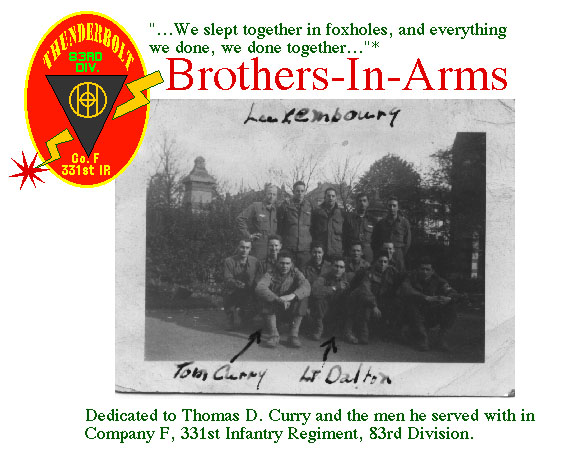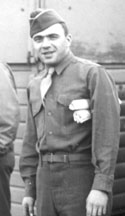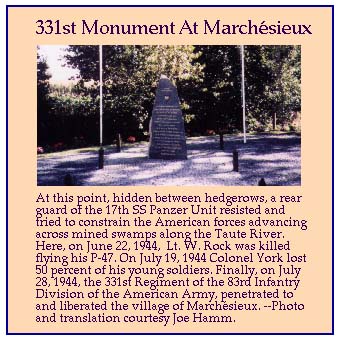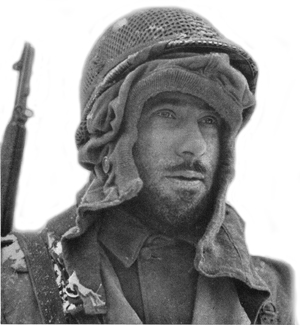

email _ | _ 83rd Division "Thunderbolt" Message Board _
*The quote near the top of this page is from a letter written by Pfc. Clarence W. Brown to my mother. Written in May 1945, six months after my father was killed in action in Gey, Germany, the letter has a simple honesty that touches the heart. It expresses a basic truth that was obvious to every GI on the front lines in Europe, but evades most of us until we realize the brutal conditions that they were forced to endure. The literal truth of what Clarence Brown wrote was that GIs slept huddled together in foxholes, at times with their arms wrapped around each other to keep from freezing to death, or stood sleeping in groups of three like human tripods when the ground was too frozen to dig into. They fought for each other and died for each other and, as the 331st Infantry motto said, they did "See It Through." They truly were brothers-in-arms.
My father, Thomas Dickson Curry, was a member of Company F, 2nd Battalion, 331st Infantry Regiment, 83rd Division. The 83rd entered France on the 21st through 24th of June 1944. They landed across Omaha Beach and from there, they fought all across Europe. The men of the 83rd Division weren't just on the front line. Most of the time they were in the center of the front line, and often out in front leading the way. They not only fought in Normandy and Brittany, but liberated Luxembourg. They fought in the Ardennes, facing the point of the German Bulge. They fought in the Rhineland, and were the first to reach the Rhine. They literally raced across the rest of Germany, covering 280 miles in 13 days and were within 60 miles of Berlin when they were ordered to stop.
The amount of ground covered by the 83rd Division from Normandy in June 1944 to Central Germany in April 1945 is difficult to comprehend--over 1,400 miles. Click here to see the trail of the 83rd.
The 83rd had three infantry regiments, the 329th, the 330th, and the 331st. They spent 244 days in combat and suffered 23,980 casualties, 15,248 of which were combat casualties. Overall, the division had 170.2 percent replacements. Of the 68 divisions deployed by the U.S. Army in the European Theater, the 83rd was ninth in the number of combat deaths. The number of 83rd Division GIs killed in combat totaled 3,620. The odds were that if you were on the front line, you probably wouldn't make it home in one piece, if at all.
Please visit the Brothers-In-Arms Memorial Page honoring the more than 1,000 men of the 331st Infantry who were killed or missing in action.
The photo at the top of this page--taken around Thanksgiving time--is, according to Larry Dalton, what was left of the 2nd platoon--less than half strength. Larry was able to identify most of the GIs in this photo. They are, from left to right, first row: my dad--Thomas D. Curry; Larry Dalton (field promotion to 2nd Lt., Silver Star); Dominic Colestro (runner until Luxembourg); and "Doc" Berrardi (platoon medic). Second row, left to right are: Willard Strauss (B.A.R. man); Pfc. Clarence W. Brown; Pvt. Smith; S/Sgt. William T. Oliver; unidentified GI. Third row, left to right are: S/Sgt. Kerr; Pvt. Leon Collins; S/Sgt. D. Root; S/Sgt. Charles P. Nelson; and James R. Duncan (runner after Luxembourg). Click here to see a photo of the 2nd platoon taken in September 44, when it was at full strength.
S/Sgt. William T. Oliver is one of the GIs in the photo at the top of this page. When Sgt. Oliver returned home, he brought with him a remarkable collection of F Company photos. You can learn more about Sgt. Oliver and view many of the photos by clicking here.
 Although he was a young man, my father was ancient by Army standards. He was 30 years old when called to active duty, and 31 when killed in action. He was probably referred to as an "old man" by most of the other men in his company. He was not a large man, but my mother said the Army "built him up," and he never looked better. Even so, his ETO Enlisted Man's Identification Card lists his weight at 139 pounds. At a height of 5 ft. 7.5 in., he probably didn't have an ounce of fat on his body.
Although he was a young man, my father was ancient by Army standards. He was 30 years old when called to active duty, and 31 when killed in action. He was probably referred to as an "old man" by most of the other men in his company. He was not a large man, but my mother said the Army "built him up," and he never looked better. Even so, his ETO Enlisted Man's Identification Card lists his weight at 139 pounds. At a height of 5 ft. 7.5 in., he probably didn't have an ounce of fat on his body.
He had brown hair and brown eyes, and a ruddy complexion attributable to his Scotch-Irish ancestry. Ironically, like many GIs, he also had German ancestry. (My grandmother said that even though she was German, she hated the Germans for what they had done.) His Scotch-Irish pioneer ancestry also gave him mental toughness and Yankee ingenuity. This, combined with coming of age during the great depression, taught him how to make do with what was at hand.
He was called to active duty on 26 October 1943, and was sent to the active duty reception center in New Cumberland, Pa. From there he went to Camp Blanding in Starke, Florida where he underwent basic training. He was in Company B, 231st Infantry Training Battalion. The unit included men from Pennsylvania, Ohio, Virginia, Michigan, New York, Illinois, Indiana, New Jersey, Wisconsin, Maryland, North Carolina, Kansas, Connecticut, Kentucky, Washington, D.C., Tennessee, and even included T/Sgt. P.E. Rhodes from Pretoria, South Africa. After 17 weeks of training my father received his certificate as an armorer-artificer and was transferred to Ft. George Meade, Maryland on 4 March 1944.
My dad became part of F Company/331st Infantry Regiment on 17 July 1944. He was moved to the front lines, 2 and 3/4 miles south of the town of Sainteny, along with 45 other GIs from the 41st Replacement Battalion that was stationed at Treviers, south of Omaha Beach. Others in this group that went to F Company were William T. Oliver, Hubert L. Smith, James Stansell Jr., Archie Swindle, John M. Tarnowksi, Earl Tillman, Augustine Toya, Paul Tweed, James Vanden, Lee R. Weeks, John W. Phillips, Albert Popik, Raymond H. Heiber, Donald Palmatier, David W. Parrish, Angelo Patricola, Jospeph Pavek, Joseph T. Pawlowski, Benjamin B. Peluso, Norman Perez, Charles Petritis, John J. Petrizzo, Donald P. Smith, Perry D. Johnston, Walter P. Kowal, Ralph R. McDowell, Thomas K. McKee, Henry L. McManus, Raymond J. Miller, Dominick Salierno, Willard H. Strauss, James F. Varley, George H. Harrell, Michael Harris, Alfred L. Hinchey, Albert K. Jeffries, Earnest C. Goates, Joseph A. Gonzales, Raphael E. Duvall, Alois Dzieweczynski, Clifford E. Olson, Raymond J. Travers, Ovid K. Seville, Francis Soucie, and Max A. Rubin.
The photo below is the original Company F before they shipped out. It was taken at Camp Breckenridge, KY, after the Tennessee maneuvers. Click on the image for a larger view. Photo courtesy Jon Aller and Kevin Harris. Another photo taken at Camp Breckenridge, showing M Company/331st, can be seen by clicking here. We have recently added a photo of A Company/331st. It can be seen by clicking here.


George Terhanko never wanted to be First Sergeant of F Company. He said he would take the job for 30 days to see how it worked out. When the war ended, Terhanko had four Purple Hearts and Silver and Bronze Stars. Click on the First Sergeant stripes to read his story.
Richard E. Chipps was also a First Sergeant--of L Company. Click here to read some of his story and to see photographs of L Company/331st Infantry.
Normandy
The 83rd was held in reserve until after D-Day, and entered France on 21 through 24 June. They landed across Omaha Beach and took over defensive positions near Carentan, where they relieved the 101st Airborne around the end of the month. Stephen Ambrose, in his book "Band Of Brothers," quotes one of the men of the 101st Airborne about the arrival of the 83rd. He said they were "so clean looking, with a full compliment of men in each unit. Even the paint on their helmets looked as if they had just been unpacked." That would soon change.
When the 83rd Division landed across Omaha Beach in June 1944, James Shonak was Captain of Anti-Tank Company/331st Infantry. Col. Shonak recalls those brutal days in a series of letters, which for the first time tell the true horror of warfare in the Normandy hedgerows: "God we lost a lot of men. My worst nightmares are still in those rows."
On 4 July, the 83rd Division left Carentan and moved south toward Sainteny, a short march of about four miles that quickly turned into a six-day battle claiming over 1,400 casualties in the first 24 hours. By the time Sainteny was taken on 10 July, that number multiplied to 3,264.
On the first day, the 83rd jumped off along the Carentan-Periers road, with the entire division artillery in support. In the 331st, the 2nd and 3rd battalions jumped off abreast at 0445 hours from the vicinity of Meautis. The assault against the German 17th SS Division and 6th Parachute Regiment was slow and costly. They fought their way through swamps that the Germans created by flooding the fields. The Germans knew the routes that the 83rd would have to take, and from concealed positions dug beneath the hedgerows, they ranged in on the advancing GIs with mortars and artillery. While the 2nd Battalion of the 331st was attacking south, the 2nd Battalion of the 329th Infantry was attacking west to an "island" in the swamp.
The next day the rest of the 329th entered the line, smashed through almost a mile to capture Coulot, and eased the pressure against the left of the line where the 330th had repelled repeated enemy counterattacks. Then, German attempts to organize tank-supported counterattacks were shattered by the 83rd's field artillery battalions. Engineers picked their way through mine fields and booby traps to clear the way. At times they had to blast supply routes through the hedges. Tanks, tank destroyers and armored infantry aided the attack. Casualties were heavy. Fallen GIs were replaced by new men, and they pushed on to take Hotot on 7 July.
They advanced toward the Taute River while rain soaked the earth and drenched their already muddy fatigues. On 8 July, they fought through hedgerows to the village of Auxais, and finally on the 10th, the 331st captured Sainteny after an attack supported by fire from 19 artillery battalions. By 15 July, the 83rd had regrouped along the Ays River.
Robert A. Turner, A Company, 331st Infantry Regiment lost his right arm to enemy tank fire and became a prisoner of war on 16 July 1944. Click here to read more of his story.
The 83rd's position placed them in just the right spot for a front-row view of what was, according to Michael Doubler in his book "Closing With the Enemy," the largest air-ground operation ever attempted by American forces. Operation COBRA began the morning of 25 July. Over 1,500 heavy bombers dropped 3,300 tons of bombs to saturate the entire target area. Then, more than 380 medium bombers dropped 650 tons of high-explosive and fragmentation bombs, while 550 fighter-bombers dropped more than 200 tons of high-explosive and napalm. The 3.5 by 1.5 mile target area was only 1,500 yards in front of the American line. There was fear that this was too close for heavy bombing and, in fact, many GIs were killed that day by short bombing runs.
Heartpounding does not adequately describe the experience of watching all this at close range. It must have seemed that the world was coming to an end, as wave after wave of bombers delivered continuous shockwaves of exploding bombs that shook the earth and turned it into a lunar landscape. A GI in the 9th Division described the scene from his foxhole. It started with small spotter aircraft that marked the targets with flares. Then the heavies came in low, a hundred at a time. The sound of all those bombs exploding at the same time was the most terrible sound that he had ever heard. The air was choked with dust so thick that they couldn't see, and the concussion so great that their clothing ballooned out. On the right of the 9th Division, the men of the 83rd felt like standing in their foxholes and cheering when they saw all those bombers.
On 26 July, the 83rd entered the pursuit, and in heavy combat crossed the Taute River the next day. They cut the St. Lo-Periers road, and forced their way into Le Mesnil Vigot. The drive carried them eight miles beyond their starting point.

There are numerous monuments in France honoring the GIs of the 83rd Division. Gilles Billion, an 83rd Division Re-enactor, has provided photos for many of these monuments. You can see them by clicking here.
Brittany
The 83rd Division then assembled near Feugeres, and on 3 through 5 August they moved out of the Cotentin Peninsula and turned west into Brittany. The roads were strewn with German tanks, trucks and staff cars, and often with dead Germans. On the coast near Mont St. Michel, Pontorson, and Dol-de-Bretagne they received orders to capture the port towns of St. Malo and Dinard.
St. Malo was the main port on the northern coast of Brittany. Because of its turbulent past as a privateer stronghold, the town was protected by stone walls. U.S. Intelligence estimated between 3,000 and 6,000 German troops occupied St. Malo. Actually 12,000 defended the walled city, and they vowed to "fight to the last stone." It would take two weeks of street fighting to raze St. Malo. On 6 August, the Germans demolished all the quays, locks, breakwaters and harbor machinery and set fire to the city. On 9 August, the enemy defenders were forced back to the Citadel at St. Servan and to Dinard on the west bank of the river just opposite St. Malo. There they held the GIs at bay from underground pillboxes and camouflaged strong points. Days of house-to-house fighting under thick smoke, artillery fire, and fighter-bomber attacks could not convince the Germans to give up. Finally, direct hits by 8-in. guns destroyed much of the enemy artillery and machine gun emplacements and forced them to surrender. Frank Reichmann in the 1st Battalion of the 331st said that a platoon of captured Germans started singing farewell to their commander. Most of them were in tears.
On 16 August my father was awarded the Combat Infantryman Badge for displaying exemplary conduct in action against the enemy in France.

Luxembourg
On 25 September the 83rd Division crossed into Luxembourg. They moved out of the Loire Valley in France, and traveled two days and nights through cities and towns, many of which brought memories of their fathers and WWI. The journey took them through the thick forests of the highland country east of Verdun. As they peeled off and took their positions they relieved elements of the 90th Division, the V Corps, and the 112th Infantry of the 28th Division.
The 83rd Division command post was in a school building in the city of Luxembourg. Those who passed through the city were greeted by banners stretched across the streets, proclaiming "Welcome to our Liberators." Store windows were full of photos of the 5th Armored Regiment which had liberated the city just nine days before. The people still seemed surprised at the sight of American soldiers in their city.
The 83rd Division has special ties to Luxembourg. They did not know it then, but they would remain in Luxembourg longer than they had in England. Most Luxembourgers spoke several languages, and many spoke some English. Cafes were opened where the GIs could enjoy good Luxembourg beer, music, and dancing. The men of the 83rd finally had some breathing space, and they began to forget about the formidable Siegfried Line waiting for them across the Moselle. The 83rd spent Thanksgiving in that tiny country. Although it was not the same as being at home, the people of Luxembourg opened their homes to the GIs.
The 331st was the first regiment in the 83rd Division to see action in Luxembourg. They captured Greveldange with little opposition. And as patrols ventured toward Remich, the 331st occupied the towns of Remerschen, Assel, and Bous. The only Germans encountered were patrols. Later, a German counterattack, supported by machine guns and mortars struck from high ground southeast of Greveldange, but the men of the 331st quickly turned back the attempted disruption of their lines.
As the 2nd Battalion advanced further toward Remich, they knocked out machine guns that the enemy had emplaced in concrete. It took the direct fire of the attached 774th tank battalion to accomplish this. After taking the towns of Wallenstein, Bech and Kleinmacher, they captured Schengen. For the first time in more than a month, they faced heavy artillery fire. German guns in the Siegfried Line east of the Moselle poured salvos into the lines, resulting in 30 casualties, the heaviest losses in over a month. They continued the mission, and took Remich on 28 September. The 3rd Battalion captured the high ground northwest of Ehnen, but had to fight through heavy machine gun and mortar fire to do it.
From the 1st through the 5th of October, the 83rd advanced in heavy combat to the West Wall across the Sauer as the 329th fought the battle for Grevenmacher. On the 7th, the 329th took the city of Echternach on the Sauer River.
October 8"There isn't a lot to write about over here. I sure wouldn't want to live the way they do. The barn and the house are all built together and the front yard is the stable yard. Doesn't seem to be very sanitary but most of the people seem to be healthy as hell, in fact they seem to thrive on it."TDC
October 29"We had quite a little treat the other day--the first real hot bath I've had since I left England (quite a topic for correspondence.)"TDC
On 5 November, the 83rd, as part of Operation UNICORN, took Le Stromberg Hill near Basse Kontz after extended fighting and defeated several counterattacks.
November 14"It looks like we not only will have to lick these supermen, but will have to go in and knock their heads off."TDC
November 19"I just got my ballot the other day, so threw it away. I see by the returns that the election didn't amount to much this time. I guess the people must be used to voting for F.D.R. All I hope is that he puts these Germans in their place, when this is over. Someone will have to fix them, so they won't start another war in a few more years, and I think he is the man that can do it. I'd hate to think of our son having to grow up to fight."TDC
Thanksgiving 1944
A few days before Thanksgiving, Company F moved from a school house in Luxembourg City north to the town of Wecker. They were billeted in an old chateau that was, according to Hershell McIntosh, complete with a kitchen full of dishes and silverware. The day before Thanksgiving, Hershell asked for two volunteers to help him cut up turkeys. My dad and Sherman Curry (no relation, but both were killed on 10 December) pitched in to help prepare the birds for the Thanksgiving feast.
November 22"Here it is, another Thanksgiving Day that I won't be home. I hope it is the last one this way. We still have a lot to be thankful for; some of the things that happen over here don't seem possible...The mail situation is bad again, probably due to the Christmas rush. I got a half-dozen packs of cigarettes from Mom the other day and they just got here in time--we didn't get any for a few days, so you can see that we are having the same trouble over here as the people back home."TDC
November 26"I was reading an old paper today and the people over there must be nuts. According to this paper, the war was practically over and the people were just waiting to celebrate. It's funny how good the news sounds, but anyway, I hope it ends soon--the sooner the better. It is beginning to look as if they really want to get totally destroyed, and if that's what they want, they are going to get it."TDC
By 29 November the First Army had just about cleared the Hurtgen Forest and was overlooking the Roer Valley. The process had reduced two more divisions, the 4th and 8th, to tatters. The 9th Army had also been slowly advancing north of Aachen towards the Roer.
December 2"These shoes we wear are quite the thing--sometimes I think my feet would be warmer without shoes. In one of your letters you wanted to know how things were over here. I should be asking you. We hardly ever hear anything except rumors, and some of these are fantastic. About a month ago, someone over here had a paper, and there was a piece in it about some German prisoners in the States going on a strike for something or other. What the hell is wrong with the people over there? Do they think we are over here for our health? Then there are those who are quitting their jobs and going to better-paying ones. I still can't see why they can't be held to their jobs like we are."TDC
December 3"Here it is another Christmas away from home--I hope it is the last one like this. There isn't much that I can send, except the same love that I have had ever since I've known you."TDC
Hurtgen Forest and Gey, Germany
On 6 December, the 83rd gave positions along the Moselle Valley to the 22nd Infantry of the 4th Division. They moved by truck to the Hurtgen Forest west of Aachen to relieve the 12th Infantry. Nazi propaganda letters were a "Christmas present."
December 6"Tell people not to mention 'good luck.' There isn't any such thing over here. God takes care of us one way or the other."TDC
On 7 December, the 83rd Division relieved the 4th Infantry Division and attacked to clear the west bank of the Roer on 10 December. My dad was killed in action that morning as the GIs slugged their way out of the Hurtgen and advanced to the villages of Strass and Gey. John Helms said that my dad was taken out by an 88-mm artillery shell. My dad's Individual Deceased Personnel File indicates cause of death as "Shrap. Chest."--confirming John's recollection.
The 330th took Strass and the 331st took Gey, one of the most strategic points in the network of German defenses protecting the vital approaches to Duren. Every house was an arsenal with ammunition supplies stacked at each window, and every basement was reinforced with double walls of cement and steel. For three days the Nazis continued to pour reinforcements into the town. The GIs fought in a house-to-house struggle through artillery, machine gun and small arms fire. As each house was taken, it was subjected to violent enemy counterattacks. Supporting tanks were knocked out on both sides of the town by mines in the streets, bazookas, and artillery fire. Supplies could only trickle through as the Germans continuously pounded the town's approaches with artillery fire. Basements of houses became aid stations for the wounded.
From one point of high ground to another, with the support of tanks, artillery, and engineers, they moved forward through enemy anti-personnel mine fields in rain, ankle-deep mud, and snow. They pushed the Germans back through savage counterattacks and finally held the west bank of the Roer River just south of Duren five days after the initial attack from the Hurtgen Forest.
My dad's story ends here, but the 83rd's does not. They fought through the Ardennes in the bitter cold and snow to beat back the German Bulge. Then they raced through Germany. The 329th lead the way most of the time and gained fame as the "Rag-Tag Circus" as they rode through the German provinces on tanks, motorcycles, jalopies, and any other means of transportation they could find. The 331st sped along not far behind on the flank. They raced across the German countryside until they were ordered to stop less than 60 miles from Berlin. The 330th, detached from the 83rd, helped clean out the Harz Mountains, a pocket of resistance that had been bypassed by the fast riding 329th and 331st.
The GIs of the 83rd Division were awarded one Medal of Honor, one Distinguished Service Medal, five Legions of Merit, 798 Silver Stars, 34 Soldier's Medals, 7,776 Bronze Star Medals, 4,747 Purple Hearts, 271 Medical Badges, 20 Meritorious Service Unit Plaques, and 106 Air Medals. They were honored with 18 British Awards and 65 French Awards. They destroyed 480 enemy tanks, 61 enemy planes, 29 enemy supply trains, and 966 enemy artillery pieces. At the end, the 83rd Division, born in war, was disbanded and all its men reassigned to other units. There were no welcoming home parades for the Thunderbolt Division, but the GIs of the 83rd would carry its memory home with them.
On The Home Front: Life was not easy on the home front, but my mom more than managed--she carried on, and made a new life for us while enduring what many would consider unbearable sorrow.
 A Combat Medic's Story: Charles Pierson Mobley was a combat medic in G Company, 331st Infantry. He and all those other "Docs" were the heroes of the infantrymen--and served on the front lines with them.
A Combat Medic's Story: Charles Pierson Mobley was a combat medic in G Company, 331st Infantry. He and all those other "Docs" were the heroes of the infantrymen--and served on the front lines with them.We believe that Pfc. Mobley was the same medic that Robert Parsons (Sarge) describes in his book "Remembrances." He fits the description that Sarge gives of the medic, and he is also from Alabama--as Sarge recalled. (Incredibly, both Charles Mobley and Sarge were born on Cotton Avenue in Birmingham.) Mobley is almost certainly the same person that Sarge walked out of Gey, Germany with in December 1944. The chances that the six-foot tall, slim medic from Alabama, known as "Mob" or "Moe," was someone other than Charles P. Mobley are almost too remote to consider.
Pfc. Mobley wrote after the war to tell his wife where he had been and what he had done all those long months away from home. His letter is the incredible story of a GI's journey through the war. You can read it by clicking here, or on the Combat Medic's Badge. Thanks to Kathy Mobley Mathews for allowing us to use this material.
83rd Infantry Division Legacy Chapter Email Group
Mapping the Overlays: 83rd Division maps for Normandy Campaign
Samuel J. Bifano--B Battery, 324th Field Artillery
83rd Division Reenactment Website
The Drive To the Elbe
Sgt. W. L. Arnold--AT Company, 329th Infantry Regiment
Pvt. Henry Irving Tannenbaum--Company F, 331st Infantry Regiment
They Served With Honor; A World War II Family Website
AWON Memorial Web Page, Massacre at Ottre
"Thank You Eddie Hart" Documentary Website (Company G, 329th Infantry)
Pfc. Melvin V. Park, K Company, 329th Infantry, 83rd Division
Liberation of Langenstein Concentration Camp by 83rd Division
Frank Monan, A Company, 331st Infantry
Everett W. Singleton, Sr., G Company, 331st Infantry
Byron Herde, 331st Infantry
From Atterbury to the Elbe
83rd Infantry, 329th Reenactment Group, Reading, PA
The 330th Infantry Across Europe
The Thunderbolt Across Europe
S/Sgt Joseph Arnaldo, 331st Infantry
Indiana Military Organization (Camp Atterbury) Website
From Normandy To the Bulge
S/Sgt Joseph Arnaldo at the Battle of the Bulge.
Photo from "We Saw It Through,"
the official history of the 331st Infantry, 83rd Division.

These eyes have seen the bloody hedgerows in the rain.
They've seen the tree bursts in the Hurtgen,
And the lifeless forms half buried in the snow
In the slaughter at Bihain.
See It Through! The call to victory beckons.
See through the mindless death and grinding pain.
Damn these eyes, they've seen too much
To see it through again.

